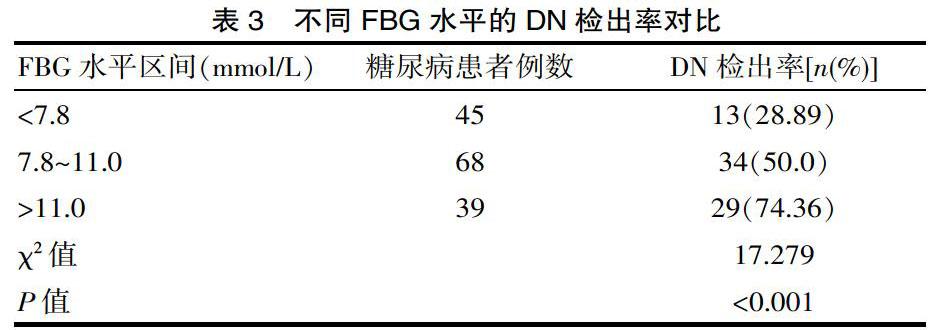陈燕波:糖化血红蛋白、空腹血糖、尿微量白蛋白检测对糖尿病肾病患者的意义分析
2020-12-06陈燕波
陈燕波



DOI:10.16658/j.cnki.1672-4062.2020.20.065
[摘要] 目的 探索糖化血紅蛋白(HbA1c)、空腹血糖(FBG)、尿微量白蛋白(mALB)在糖尿病肾病患者诊疗中的应用价值。 方法 于该院2018年10月—2019年11月收治的糖尿病肾病患者中选出76例为DN组,并选取同期收治的单纯糖尿病患者中选出76例为糖尿病组,选取同期体检的健康人76名为对照组,均进行糖化血红蛋白、空腹血糖和尿微量白蛋白检测。 结果 3组对象的HbA1c、FBG、mALB水平比较:对照组<糖尿病组
[关键词] 糖化血红蛋白;空腹血糖;尿微量白蛋白;糖尿病肾病
[中图分类号] R587.2 [文献标识码] A [文章编号] 1672-4062(2020)10(b)-0065-03
Significance Analysis of Glycosylated Hemoglobin, Fasting Blood Glucose and Urine Microalbumin in Patients with Diabetic Nephropathy
CHEN Yan-bo
Department of Laboratory Medicine, Puning People's Hospital, Puning, Guangdong Province, 515300 China
[Abstract] Objective To explore the application value of glycosylated hemoglobin (HbA1c), fasting blood glucose (FBG) and urine microalbumin (mALB) in the diagnosis and treatment of diabetic nephropathy. Methods From October 2018 to November 2019 in the hospital, 76 patients with diabetic nephropathy were selected as the DN group, and 76 patients with simple diabetes admitted in the same period were selected as the diabetes group, and healthy people who had physical examinations during the same period were selected 76 people were in the control group, all were tested for glycosylated hemoglobin, fasting blood glucose and urine microalbumin. Results Comparison of HbA1c, FBG and mALB levels of the three groups of subjects: control group <diabetes group <DN group, the difference between the two comparisons was statistically significant(P <0.001); the detection rate of DN in patients with HbA1c level <6.0% was 23.08%. The detection rate of DN in patients with HbA1c level between 6.5%~9.0% was 52.11%, and the detection rate of DN in patients with HbA1c level>9.0% was 71.43%, the difference was statistically significant(P<0.001); FBG<7.8 mmol/L patients' detection rate of DN was 28.89%, the detection rate of DN in patients with FBG between 7.8 and 11.0 mmol/L was 50.0%, and the detection rate of DN in patients with FBG>11.0 mmol/L was 74.36%. The difference was statistically significant(P<0.001). Conclusion The combined test of glycosylated hemoglobin, fasting blood glucose and urine microalbumin in the diagnosis of diabetic nephropathy is helpful for early detection of diabetic nephropathy and guide clinical treatment.
